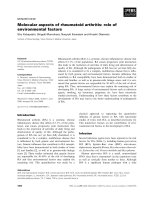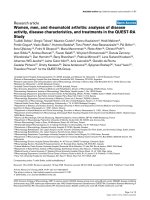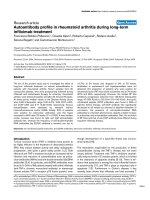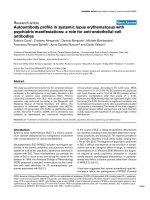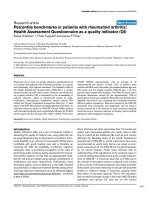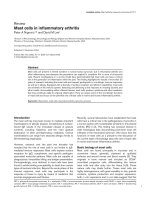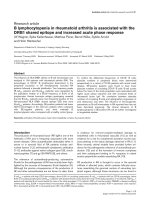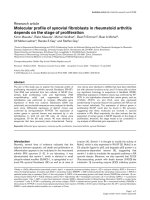Báo cáo y học: " Autoantibody profile in rheumatoid arthritis during long-term infliximab treatment" pdf
Bạn đang xem bản rút gọn của tài liệu. Xem và tải ngay bản đầy đủ của tài liệu tại đây (186.87 KB, 9 trang )
Open Access
Available online />R264
Vol 6 No 3
Research article
Autoantibody profile in rheumatoid arthritis during long-term
infliximab treatment
Francesca Bobbio-Pallavicini
1
, Claudia Alpini
2
, Roberto Caporali
1
, Stefano Avalle
2
,
Serena Bugatti
1
and Carlomaurizio Montecucco
1
1
Department of Rheumatology University of Pavia, IRCCS Policlinico S. Matteo, Pavia, Italy
2
Clinical Chemistry Laboratories University of Pavia, IRCCS Policlinico S. Matteo, Pavia, Italy
Corresponding author: Francesca Bobbio-Pallavicini,
Received: 22 Jan 2004 Revisions requested: 10 Feb 2004 Revisions received: 27 Feb 2004 Accepted: 09 Mar 2004 Published: 26 Apr 2004
Arthritis Res Ther 2004, 6:R264-R272 (DOI 10.1186/ar1173)
http://arthr itis-research.com/conte nt/6/3/R264
© 2003 Bobbio-Pallavicini et al.; licensee BioMed Central Ltd. This is an Open Access article: verbatim copying and redistribution of this article are
permitted in all media for any purpose, provided this notice is preserved along with the article's original URL.
Abstract
The aim of the present study was to investigate the effect of
long-term infliximab treatment on various autoantibodies in
patients with rheumatoid arthritis. Serum samples from 30
consecutive patients, who were prospectively followed during
infliximab and methotrexate therapy for refractory rheumatoid
arthritis, were tested at baseline and after 30, 54 and 78 weeks.
At these points, median values of the Disease Activity Score
were 6.38 (interquartile range 5.30–6.75), 3.69 (2.67–4.62),
2.9 (2.39–4.65) and 3.71 (2.62–5.06), respectively. Various
autoantibodies were assessed by standard indirect
immunofluorescence and/or ELISA. Initially, 50% of patients
were positive for antinuclear antibodies, and this figure
increased to 80% after 78 weeks (P = 0.029). A less marked,
similar increase was found for IgG and IgM anticardiolipin
antibody titre, whereas the frequency of anti-double-stranded
DNA antibodies (by ELISA) exhibited a transient rise (up to
16.7%) at 54 weeks and dropped to 0% at 78 weeks.
Antibodies to proteinase-3 and myeloperoxidase were not
detected. The proportion of patients who were positive for
rheumatoid factor (RF) was similar at baseline and at 78 weeks
(87% and 80%, respectively). However, the median RF titre
exhibited a progressive reduction from 128 IU/ml (interquartile
range 47–290 IU/ml) to 53 IU/ml (18–106 IU/ml). Anti-cyclic
citrullinated peptide (CCP) antibodies were found in 83% of
patients before therapy; anti-CCP antibody titre significantly
decreased at 30 weeks but returned to baseline thereafter. In
conclusion, the presence of anti-double-stranded DNA
antibodies is a transient phenomenon, despite a stable increase
in antinuclear and anticardiolipin antibodies. Also, the evolution
of RF titres and that of anti-CCP antibody titres differed during
long-term infliximab therapy.
Keywords: anti-citrullinated peptide antibodies, anti-dsDNA antibodies, antinuclear antibodies, infliximab, rheumatoid factor
Introduction
Tumour necrosis factor (TNF)-α inhibitors have proven to
be highly effective in the treatment of rheumatoid arthritis
(RA); they reduce disease activity and delay radiographic
progression, with quite a good safety profile [1,2]. Side
effects of anti-TNF-α treatment include an increased risk for
infection and induction of autoantibodies such as antinu-
clear antibodies (ANAs) and anti-double-stranded (ds)DNA
antibodies [3,4]. In particular, anti-dsDNA antibodies were
found in 5–20% of RA patients treated with either infliximab
(anti-TNF-α chimeric monoclonal antibody) or etanercept
(human soluble TNF-α receptor p75 fusion protein), even
though development of a lupus-like illness was encoun-
tered rarely [3-8].
The mechanism responsible for the production of these
autoantibodies during anti-TNF-α therapy has not been
clearly defined. Treatment with TNF-α inhibitors dramati-
cally reduces levels of C-reactive protein, which is involved
in the clearance of apoptotic bodies [9,10]. There is evi-
dence that apoptosis is among the most influential factors
in autoimmunity [11], and TNF-α plays an important role in
apoptosis [12]. Furthermore in Crohn's disease it has
recently been shown that infliximab can bind activated T
aCL= anticardiolipin; ACR = American College of Rheumatology; ANA = antinuclear antibody; ANCA = antineutrophil cytoplasmic antibody; CCP =
cyclic citrullinated peptide; ds = double-stranded; DAS 28 = Disease Activity Score; DMARD = disease-modifying antirheumatic drug; ELISA =
enzyme-linked immunosorbent assay; EMA = antiendomysial antibody; ENA = extractable nuclear antigen; IIF = indirect immunofluorescence; MPO
= myeloperoxidase; PBS = phosphate-buffered saline; PR3 = serine protease 3; RA = rheumatoid arthritis; RF = rheumatoid factor; SLE = systemic
lupus erythematosus; TNF = tumour necrosis factor.
Arthritis Research & Therapy Vol 6 No 3 Bobbio-Pallavicini et al.
R265
cells and monocytes, inducing apoptosis [13,14]. Finally,
inhibition of TNF-α – a pivotal T-helper-1 cytokine – could
favour a T-helper-2 response, leading to an increased
(auto)antibody production.
Although many studies have investigated the ANA and anti-
dsDNA antibody profile in RA, as well as in other chronic
inflammatory diseases, after anti-TNF-α treatment [15,16],
only few data are available regarding the behaviour of these
antibodies after the first 6 months of treatment in RA. Fur-
thermore, no data are currently available in RA patients
regarding the long-term effect of anti-TNF treatment on
other autoantibodies, including rheumatoid factor (RF) and
anti-cyclic citrullinated peptide (CCP) antibodies, levels of
which are related to the severity of the rheumatoid process
[17-20] and could be reduced by an effective antirheumatic
therapy [21].
The present study was conducted to evaluate a large panel
of autoantibodies, including RF and anti-CCP antibodies, in
a cohort of RA patients prospectively followed during 78
weeks of treatment with infliximab.
Materials and methods
Patients
Thirty-nine consecutive patients fulfilling the American Col-
lege of Rheumatology (ACR) classification criteria for RA
[22] started treatment with infliximab plus methotrexate
between June 2000 and June 2001 at the Department of
Rheumatology of the Pavia University Hospital and were
prospectively followed up.
Thirty patients completed 78 weeks of therapy, and their
autoantibody profiles were evaluated after informed con-
sent, according to the local ethical committee recommen-
dations, had been obtained. Four patients dropped out
because of side effects; in three patients infliximab was
stopped between 14 and 30 weeks because of lack of clin-
ical response; one patient was lost to follow up because of
change of residence; and one was lost to follow-up after 14
weeks because of unsatisfactory response and fear of
potential side effects (information obtained by telephone
contact). The demographical and clinical characteristics of
the 30 patients studied are shown in Table 1.
Before infliximab treatment was begun, all patients had a
Disease Activity Score (DAS 28) [23] greater than 4.9
despite combination therapy with at least two conventional
disease-modifying anti-rheumatic drugs (DMARDs),
including methotrexate. No patient had an infectious dis-
ease, active or latent tuberculosis, neoplastic disease,
heart failure, cytopenia, or a demyelinating disorder.
Infliximab (3 mg/kg) was administered intravenously at 0, 2
and 6 weeks, and then every 8 weeks along with methotrex-
ate (15–20 mg/week), according to the ATTRACT protocol
[3]. Nonsteroidal anti-inflammatory drugs and oral pred-
nisone (= 7.5 mg/day) were also permitted. A careful clini-
cal evaluation was conducted in all patients just before
each infliximab infusion. Response to therapy was evalu-
ated according to the ACR response criteria [24], as well
as by changes in DAS 28 [23] and serum C-reactive pro-
tein levels.
Serum samples for detection of autoantibodies were col-
lected, and stored at -70°C, just before the first infliximab
infusion and at 30, 54 and 78 weeks of therapy. Serological
investigations were carried out at the end of the study in all
serum samples taken at the different time points. Thirty age-
matched and sex-matched healthy blood donors were
investigated as a control group.
Antinuclear antibodies
ANAs were tested by a standard indirect immunofluores-
cence (IIF) technique as previously described [25], using a
BX 51 Olympus fluorescence microscope (Olympus Opti-
cal Co., Hamburg, Germany) at 40 × power. Serum was
Table 1
Main demographic and clinical characteristics of the present
series (30 patients)
Parameter Value
Age (years) 57.13 ± 9.21
Female/male 24/6
Duration of disease (years) 9.43 ± 8.97
Number of of tender joints 16.46 ± 9.1
Number of swollen joints 6.83 ± 4.814
RF positivity 86.70%
Joint erosions 100%
Serum CRP (mg/dl) 3.85 ± 2.74
DAS 28 6.1 ± 1.025
HAQ 1.78 ± 0.422
Previous DMARDs
Methotrexate 30
Hydroxycloroquine 26
Sulfasalazine 18
Cyclosporin A 19
Gold (intramuscular) 3
Leflunomide 1
Azathioprine 1
Where applicable, values are expressed as ± standard deviation.
CRP, C-reactive protein; DAS 28, Disease Activity Score; DMARD,
disease-modifying antirheumatic drug; HAQ, Health Assessment
Questionnaire; RF, rheumatoid factor.
Available online />R266
first diluted 1:80 in phosphate-buffered saline (PBS) and
overlaid onto fixed Hep2 cell slides (Immuno Concept, Sac-
ramento, CA, USA) in a moist chamber for 30 min at room
temperature. Slides were then rinsed and washed twice in
PBS for 10 min. A fluorescein-labelled antibody specifically
directed toward human IgG (γ chains; Delta Biologicals,
Pomezia, Italy) was used as fluorescence conjugate. The
positive samples (titer = 1:80) were then evaluated at
increasing dilutions in PBS up to 1:640.
Anti-double-stranded DNA antibodies
Anti-dsDNA antibodies were determined both by IIF and
quantitative ELISA. IIF was performed at 1:10 serum dilu-
tion in PBS using Crithidia luciliae as substrate (INOVA,
San Diego, CA, USA) and antihuman IgG (γ chain specific)
as fluorescence conjugate (Delta Biologicals). ELISA was
performed using a commercially available kit (Axis-Shield,
Dundee, UK) according to the manufacturer's recommen-
dations. Alkaline phosphatase-labelled murine monoclonal
antibodies to both human IgG and IgM (heavy and light
chains) were used. The absorbance was read at 550 nm.
Serum samples were evaluated in triplicate and the median
value was considered. The upper normal limit, according to
the recommendations of the manufacturer, was 30 UI/ml.
Anticardiolipin antibodies
Commercially available ELISA kits (Orgentec Diagnostika,
Mainz, Germany) were used to detect IgG anticardiolipin
(aCL) and IgM aCL, by means of a peroxidase conjugate
solution of either polyclonal rabbit antihuman IgG (heavy
and light chains) or polyclonal rabbit antihuman IgM (heavy
and light chains) according to the manufacturer's instruc-
tions. The absorbance was read at 450 nm. Serum samples
were evaluated in triplicate; the upper normal limits were 10
U/ml for IgG aCL and 7 U/ml for IgM aCL.
Rheumatoid factor and anti-cyclic citrullinated peptide
antibodies
IgM RF was measured by immunonephelometry using the
quantitative N Latex RF system (Dade Behring, Marburg,
Germany). RF concentrations higher than 15 IU/ml were
considered positive.
Anti-CCP antibodies were tested using a new, second gen-
eration, commercially available ELISA kit (Axis-Shield).
Briefly, 100 µl anti-CCP standards (0, 2, 8, 30 and 100 U/
ml), controls and patient samples (1:100 in PBS) were dis-
tributed into the appropriate wells. The microtitre plates
were coated with a highly purified synthetic cyclic peptides
containing modified arginine residues. After incubation for
60 min, the wells were washed three times with 200 µl
wash buffer (borate buffer, 0.8% [weight:volume] sodium
azide). The microplates were then incubated for 30 min at
room temperature with alkaline phosphate-labelled murine
monoclonal antibody to human IgG and washed again
three times. A chromogenic substrate solution (Mg
2+
phe-
nolphthalein monophosphate buffered solution) was added
to each well. After 30 min the reaction was stopped using
sodium hydroxide–EDTA–carbonate buffer. The absorb-
ance was read at 550 nm. Serum samples were evaluated
in triplicate, and the upper normal limit (5 UI/ml) was
assumed according to the manufacturer's recommenda-
tions. In order to follow the changes in antibody levels dur-
ing therapy, all serum samples exhibiting a high
concentration (= 100 U/ml) were evaluated after a further
10 × dilution and then corrected for this additional dilution
factor.
Other autoantibodies
Anti-extractable nuclear antigen (ENA) antibodies were
evaluated in triplicate using commercially available ELISA
kits (Axis-Shield) according to the manufacture's recom-
mendations. The following single ENA specificities were
investigated: Sm, RNP, SSA(Ro), SSB(La), Scl-70 and
Jo1.
Antineutrophil cytoplasmic antibodies (ANCAs) directed
toward serine protease 3 (PR3) and myeloperoxidase
(MPO) were also assessed using commercial ELISA kits
(Axis-Shield). Serum samples were evaluated in triplicate,
and the upper normal limit was assumed according to the
recommendations of the manufacturer.
Anti-endomysial antibodies (anti-EMAs) were detected by
IIF at 1:10 serum dilution in PBS using monkey oesopha-
gus as a substrate (INOVA) and antihuman IgA fluores-
cence conjugate (INOVA).
Statistical analysis
Fisher's exact test was run to evaluate the differences
between the number of patients with a positive result
before and after therapy. Wilcoxon's test was used to ana-
lyze variation in continuous variables. Statistical analysis
was conducted using INSTAT2 software (Graphpad Inc.
San Diego, CA, USA.)
Results
Response to therapy
ACR20 response was attained by 87% of patients at 30
weeks, by 80% at 54 weeks, and by 63% at 78 weeks.
ACR50 percentages were 60% at 30 and 54 weeks, and
47% at 78 weeks. ACR 70 percentages were 33%, 43%
and 30%, respectively.
During the course of the study the median DAS 28 value
significantly decreased from 6.38 (interquartile range
5.30–6.75) to 3.71 (interquartile range 2.62–5.06), and
the serum C-reactive protein levels from 3.2 mg/l (inter-
quartile range 2.23–4.5 mg/l) to 0.65 mg/l (interquartile
range 0.38–1.38 mg/l; Fig. 1).
Arthritis Research & Therapy Vol 6 No 3 Bobbio-Pallavicini et al.
R267
Frequency of autoantibodies
ANAs were found in 15 patients (50%) at baseline and in
24 patients (80%) at 78 weeks (P < 0.0292). Fourteen
patients were ANA positive at baseline as well as at all fol-
low-up points, whereas 1 patient with a 1:80 ANA titre at
baseline became ANA negative from 30 weeks. Seven
patients became ANA positive at 30 weeks, and two addi-
tional patients did so at 54 weeks. All these patients were
still positive at 78 weeks. Only one patient became positive
at 78 weeks. The fluorescence ANA pattern was homoge-
nous in 75% of cases after infliximab treatment.
The frequency of the other autoantibodies did not change
significantly from baseline to 78 weeks (Table 2). The num-
bers of patients who were positive for anti-dsDNA antibod-
ies at baseline, 30, 54 and 78 weeks were 2, 3, 5 and 0 by
ELISA and 1, 1, 2 and 1 by IIF, respectively. The two anti-
dsDNA antibody positive patients at baseline by ELISA
remained positive at 30 weeks of study, but only one of
them was still positive at 54 weeks and none were at 78
weeks. The only anti-dsDNA antibody positive patient by IIF
at baseline was also positive by ELISA and remained posi-
tive during the follow-up period. Regarding anti-ENA anti-
bodies, three patients were positive for anti-SSA(Ro)
before infliximab and one additional patient became posi-
tive during treatment.
At the end of the study, one patient was found to have low
levels of IgG aCL, two were found to have low levels of IgM
aCL, and one patient was positive for both. No patient was
positive for anti-MPO or anti-PR3 antibodies, or EMAs
either before treatment or during follow up.
Twenty-six patients (87%) were positive for RF at the
beginning of the study and 24 (80%) at 78 weeks, because
two patients became RF negative during the course of ther-
apy. Twenty-five patients were positive for anti-CCP anti-
bodies (83.3%), and this figure did not change at 78
weeks. Two patients with borderline values at baseline had
a negative test at 30 and 54 weeks, and a low-level positive
test at 78 weeks.
Only one out of 30 healthy control individuals had positive
ANA test (1:160) and one additional individual had border-
line (15 IU/ml) RF levels.
Autoantibody titre
ANA titre significantly increased during infliximab treat-
ment. Also, a progressively increased concentration was
found for aCL (either IgG or IgM), whereas anti-dsDNA
antibody concentration, measured by ELISA, exhibited a
transient rise at 30 and 54 weeks and returned to baseline
at 78 weeks (Fig. 2).
The RF titres exhibited a progressive and significant reduc-
tion from baseline to 30, 54 and 78 weeks. However, anti-
CCP antibody titres exhibited a significant reduction only at
30 weeks (Fig. 3). After 78 weeks reduction by 50% or
more in RF titre with respect to baseline was found in 15
patients, whereas such a reduction in anti-CCP antibody
titre was noted only in two patients. No difference was
found among responders and non-responders (according
to ACR 20 criteria) in RF and anti-CCP antibody titres
either at baseline or at 78 weeks.
Figure 1
Changes in disease activity in 30 patients with rheumatoid arthritis at different times during 78 weeks of infliximab therapy as determined by (a) Disease Activity Score (DAS 28) and (b) serum C-reactive protein levelsChanges in disease activity in 30 patients with rheumatoid arthritis at
different times during 78 weeks of infliximab therapy as determined by
(a) Disease Activity Score (DAS 28) and (b) serum C-reactive protein
(CRP) levels. The diamonds indicate median values, vertical bars indi-
cate the interquartile range, and dotted lines indicate the upper normal
limit.
DAS 28
0
1
2
3
4
5
6
7
8
Weeks
30 54
0
78
P <
0.0001 0.0001
0.0001
(a)
(b)
0
5
10
15
20
25
30
35
40
45
50
Weeks
CRP (mg/l)
30 540
78
0.0005
0.0001 0.0001
P <
P <
P <
P <
P =
Available online />R268
Autoantibody associated clinical manifestations
A 34-year-old woman developed malar rash and a mild
arthritis flare along with the appearance of anti-dsDNA anti-
bodies (detected by both IIF and ELISA) after 30 weeks of
therapy. No other signs of systemic lupus erythematosus
(SLE) were present, complement levels were normal, and
hemoglobin, blood cell counts and urinalysis were normal.
Infliximab therapy was not stopped; both malar rash and
anti-dsDNA antibodies disappeared after a few weeks and
did not recur thereafter. No other clinical signs of SLE or
antiphospholipid syndrome were found in the patients
studied.
Discussion
Induction of ANAs and anti-dsDNA antibodies during treat-
ment with anti-TNF-α agents was highlighted in clinical tri-
als and in postmarketing surveillance [3,4]. In a recent
study, detection of ANAs among RA patients was reported
to increase from 51.6% to 82.3% after treatment with inf-
liximab plus methotrexate, and even higher figures were
reported in patients with ankylosing spondylitis who were
treated with slightly higher infliximab doses without meth-
otrexate comedication [7]. In the same study anti-dsDNA
antibodies, demonstrated by both IIF and ELISA, devel-
oped in 11.3% of RA patients after 30 weeks. Interestingly,
all of the anti-dsDNA antibodies after infliximab were of IgA
and/or IgM isotype, whereas it is known that lupus-associ-
ated anti-dsDNA antibodies are classically of the IgG iso-
type [26,27]. This may explain why the actual incidence of
SLE or related disorders after infliximab treatment is very
low despite a significant rise in anti-dsDNA antibodies [3].
Nonetheless, several cases of anti-dsDNA antibodies asso-
ciated with clinical manifestations of SLE have been
reported in RA patients treated with infliximab or etanercept
[28-35], and in all but one case [33] these clinical features
disappeared completely after stopping treatment.
The results of the present study confirm induction of ANAs
and anti-dsDNA antibodies after 30 and 54 weeks of treat-
ment. Our findings are very similar to those reported by De
Rycke and coworkers [7] after 30 weeks of therapy using
comparable assays. ANAs were present in 50% of patients
before therapy and in 76.7% after 54 weeks; anti-dsDNA
antibodies were detected by ELISA in 6.7% before therapy
and in 16.7% after 54 weeks. Regarding anti-dsDNA anti-
bodies detected using IIF, we used a fluorescence-labelled
conjugate specifically directed toward human γ chains in
order to detect only the IgG anti-dsDNA that are strictly
associated with SLE [26,27]. As expected, the frequency
of these antibodies was lower, and only one patient con-
verted from negative to positive during infliximab treatment.
At long-term analysis, up to 78 weeks, there was a progres-
sive increase in the percentage of ANA-positive patients
without any clinically relevant manifestations. Unexpect-
edly, however, the percentage of anti-dsDNA antibody pos-
itive patients returned to baseline, suggesting that the
development of the latter autoantibodies may represent a
transitory phenomenon that occurs only during the early
phases of treatment. Further studies on larger series are
Table 2
Frequency of the autoantibodies assessed before therapy and at different times after initiation of infliximab treatment
Antibody Positivity (n [%]) P value
a
Before therapy From start of infliximab treatment
30 weeks 54 weeks 78 weeks
ANA 15/30 (50) 21/30 (70) 23/30 (76.7) 24/30 (80) 0.0292
Anti-dsDNA (ELISA) 2/30 (6.7) 3/30 (10) 5/30 (16.7) 0/30 (0) 0.4915
Anti-dsDNA (IIF) 1/30 (3.3) 1/30 (3.3) 2/3 (6.7) 1/30 (3.3) -
Anti-ENA
b
3/30 (10) 4/30 (13.3) 4/30 (13.3) 4/30 (13.3) 0.999
aCL IgG 0/30 (0) 1/30 (3.3) 2/30 (6.7) 2/30 (6.7) 0.4915
aCL IgM 0/30 (0) 1/30 (3.3) 2/30 (6.7) 3/30 (10) 0.2373
ANCA 0/30 (0) 0/30 (0) 0/30 (0) 0/30 (0) -
RF 26/30 (86.7) 27/30 (90) 25/30 (83.3) 24/30 (80) 0.7306
Anti-CCP 25/30 (83.3) 22/30 (73.3) 22/30 (73.3) 25/30 (83.3) -
EMA (IIF) 0/30 (0) 0/30 (0) 0/30 (0) 0/30 (0) -
a
Comparison between 0 and 78 weeks.
b
Only anti-SSA(Ro) reactivity was found. ACL, anticardiolipin; ANA, antinuclear antibody; ANCA,
antineutrophil cytoplasmic antibody; CCP, cyclic citrullinated peptide; DAS 28, Disease Activity Score; ds, double-stranded; ELISA, enzyme-
linked immunosorbent assay; EMA, antiendomysial antibody; ENA, extractable nuclear antigen; IIF, indirect immunofluorescence; RF, rheumatoid
factor.
Arthritis Research & Therapy Vol 6 No 3 Bobbio-Pallavicini et al.
R269
needed to confirm this. However, it is interesting that
almost all of the anti-TNF therapy-induced lupus syndromes
were reported within the first year of treatment [2,6,28-35].
Furthermore, the one patient in the present study who
developed lupus-like clinical features along with anti-
dsDNA antibodies exhibited a spontaneous regression of
both clinical symptoms and anti-dsDNA antibodies, even
though infliximab treatment were not stopped.
Transient spikes in aCL antibody levels were occasionally
reported following bacterial infections in RA patients
treated with infliximab [36]; however, the aCL antibody pro-
file has not previously been systematically studied in rela-
tion to anti-TNF therapy [37]. We observed a significant
increase in aCL antibody titres, starting from 30 weeks for
IgM antibodies and at 78 weeks for IgG antibodies. How-
ever, in most cases the levels did not exceed normal limits,
even after 78 weeks, and none of the patients exhibited any
clinical feature related to the antiphospholipid syndrome.
Longer follow up will clarify whether aCL antibody titres
may further increase and whether antiphospholipid related
disorders, such as thrombosis, may develop during long-
term treatment.
The development of new anti-ENA reactivity, namely anti-
SSA(Ro) and SSB(La), has occasionally been reported in
previous studies [7]. About 10% of the patients we studied
were positive for anti-SSA(Ro) at baseline (a percentage
that is to be expected in RA patients from our country [38]),
and one additional patient developed anti-SSA(Ro) during
treatment without associated clinical features. Anti-ENA
reactivity other than anti-SSA(Ro) was not detected.
We also analyzed other autoantibodies that have not been
thoroughly investigated in RA in relation to anti-TNF-α treat-
ment until now. The most relevant findings pertain to RF
and anti-CCP antibodies, because no reactivity at all was
found for MPO-ANCAs and PR3-ANCAs or for EMAs.
Figure 2
Changes in the serum concentrations of (a) antinuclear antibodies, (b) anti-double-stranded DNA antibodies, (c) anticardiolipin IgG and (d) aCL IgM in 30 RA patients at different times during 78 weeks of infliximab treatmentChanges in the serum concentrations of (a) antinuclear antibodies (ANAs), (b) anti-double-stranded (ds)DNA antibodies, (c) anticardiolipin (aCL)
IgG and (d) aCL IgM in 30 rheumatoid arthritis patients at different times during 78 weeks of infliximab treatment. In the graphs shown in panels b-d
the reported values always remained below the upper normal limits, which were 30 IU/ml for anti-dsDNA antibodies, 10 U/ml for IgG aCl and
7 U/ml for IgM aCL. The diamonds indicate median values, and vertical bars indicate the interquartile range.
0
1
2
3
4
5
6
7
aCL IgG (U/ml)
30
54
0
78
(a) (b)
(c) (d)
0
100
200
300
400
500
600
700
Weeks
ANA (titer)
30 54
0
78
P = 0.07
0
2
4
6
8
10
12
14
16
18
anti-dsDNA (IU/ml)
30
54
0
78
0
1
2
3
4
5
6
aCL IgM (U/ml)
30
540
78
Weeks
Weeks
Weeks
P = 0.13 P < 0.0001
P = 0.4423
P = 0.3302
P < 0.0001
P = 0.0065
P = 0.3306
P = 0.0191
P = 0.0001
P = 0.0092
P < 0.0002
Available online />R270
At baseline RF and anti-CCP antibodies were present in
most cases, as expected in patients with severe, erosive
RA refractory to conventional DMARD therapy [17-19].
Although we did not identify any change in the number of
positive patients, in the present study we found a signifi-
cant decrease in the titres of both anti-CCP antibodies and
RF after 30 weeks of infliximab therapy. These findings sug-
gest that serial evaluations of these antibodies could be
useful in monitoring the clinical course of RA patients
undergoing treatment with infliximab. Decreased produc-
tion of RF has been reported in association with successful
treatment with conventional DMARDs such as methotrex-
ate and gold salts [21]. However, we observed a different
evolution of RF titres with respect to anti-CCP antibody
titres during long-term therapy. At 54 and 78 weeks, RF
titres exhibited a progressive decrease whereas no
decrease was observed for anti-CCP antibody titres,
despite the persistence of clinical improvement as indi-
cated by DAS 28.
The decrease in RF titre roughly paralleled DAS 28 values,
suggesting that this measure could be regarded as an addi-
tional marker of disease activity, although we did not find
significant correlations between changes in RF and ACR
response. This lack of correlation might be due to a type 2
error related to the small sample size and, at least in part, to
the fact that four patients who stopped therapy before 34
weeks because of inefficacy had to be excluded from the
analysis. A further prospective study in a larger series of RA
patients comparing responders and nonresponders is now
in progress.
The mechanisms by which infliximab could lead to a
decrease in titres of autoantibodies such as RF and anti-
CCP are not understood and any explanation remains
speculative. Infliximab therapy has proven to reduce the
amount of synovium infiltrating cells, including plasma cells
[39]. Because RF-producing cells are present in inflamed
rheumatoid synovium and the local environment may favour
synovial RF production [40], we can speculate that the
reduction in inflammatory lymphoplasmacytic infiltrate in
rheumatoid synovium will lead to a reduced production of
RF. Our data also suggest that generation of RF and anti-
CCP antibodies may be controlled in a different manner in
RA, because inhibition of RF appears to be more depend-
ent on TNF-α blockade and more persistent than inhibition
of anti-CCP antibodies.
Conclusion
In conclusion, several autoantibodies can be induced by
infliximab therapy; however, levels of these autoantibodies
may evolve differently during long-term follow-up in RA. The
development of ANAs was persistent up to 78 weeks of
therapy, as was the rise in aCL antibody titre, without any
related clinical manifestations. On the contrary, the pres-
ence of anti-dsDNA antibodies appeared to be an early but
transient phenomenon, lasting about 1 year. This might
explain why almost all of the infliximab-induced lupus syn-
dromes were reported within the first year of treatment in
RA.
No differences in RF and anti-CCP antibody positivity were
observed even though a significant reduction in RF and
anti-CCP antibody titres was found during the course of
treatment. The reduction in RF titre was more pronounced
and persistent than that of anti-CCP antibodies, suggest-
Figure 3
Changes in the serum titre of (a) rhematoid factor and (b) anti-cyclic citrullinated peptide antibodies in 30 patients with rheumatoid arthritis at different times during 78 weeks of Infliximab treatmentChanges in the serum titre of (a) rhematoid factor (RF) and (b) anti-
cyclic citrullinated peptide (CCP) antibodies in 30 patients with rheu-
matoid arthritis at different times during 78 weeks of Infliximab treat-
ment. The diamonds indicate median values, vertical bars indicate the
interquartile range, and dotted lines indicate the upper normal limit.
(a)
(b)
0
50
100
150
200
250
300
350
Weeks
RF (IU/ml)
30
540
78
P = 0.0108
15
0
20
40
60
80
100
120
Weeks
anti-CCp (IU/ml)
5
P < 0.0001
P < 0.0001
30
540
78
P = 0.0161
P = 0.0642
P = 0.2668
Arthritis Research & Therapy Vol 6 No 3 Bobbio-Pallavicini et al.
R271
ing that the production of these antibodies may follow dif-
ferent regulatory pathways.
Competing interest
None declared.
References
1. Lipsky PE, van der Heijde DM, St Clair EW, Furst DE, Breedveld
FC, Kalden Jr, Smolen JS, Weisman M, Emery P, Feldmann M, Har-
riman GR, Maini RN, Anti-Tumor Necrosis Factor Trial in Rheuma-
toid Arthritis with Concomitant Therapy Study Group: Infliximab
and methotrexate in the treatment of rheumatoid arthritis.
Anti-tumor necrosis factor trial in rheumatoid arthritis with
concomitant therapy Study Group. N Engl J Med 2000,
343:1594-1602.
2. Genovese MC, Bathon JM, Martin RW, Fleischmann RM, Tesser
JR, Schiff MH, Keystone EC, Wasko MC, Moreland LW, Weaver
AL, Markenson J, Cannon GW, Spencer-Green G, Finck BK:
Etanercept versus methotrexate in patients with early rheuma-
toid arthritis: two-year radiographic and clinical outcomes.
Arthritis Rheum 2002, 46:1443-1450.
3. Maini R, St Clair EW, Breedveld F, Furst D, Kalden J, Weisman M,
Smolen J, Emery P, Harrimann G, Feldmann M, Lipsky P: Inflixi-
mab (chimeric anti-tumor necrosis factor alpha monoclonal
antibody) versus placebo in rheumatoid arthritis patients
receiving concomitant methotrexate: a randomised phase III
trial. ATTRACT Study Group. Lancet 1999, 354:1932-1939.
4. Moreland LW, Schiff MH, Baumgartner SW, Tindall EA, Fleis-
chmann RM, Bulpitt KJ, Weaver AL, Keystone EC, Furst DE,
Mease PJ, Ruderman EM, Horwitz DA, Arkefeld DG, Garrison L,
Burge DJ, Blosch CM, Lange ML, Mc Donnell ND, Weinblatt ME:
Etanercept therapy in rheumatoid arthritis. A randomized, con-
trolled trial. Ann Intern Med 1999, 130:478-486.
5. Maini RN, Breedveld FC, Kalden JR, Smolen JS, Davis D, Macfar-
lane JD, Antoni C, Leeb B, Elliott MJ, Woody JN, Schaible TF, Feld-
mann M: Therapeutic efficacy of multiple intravenous infusions
of anti-tumor necrosis factor α monoclonal antibody combined
with low-dose weekly methotrexate in rheumatoid arthritis.
Arthritis Rheum 1998, 41:1552-1563.
6. Charles PJ, Smeenk RJ, De Jong J, Feldmann M, Maini RN:
Assessment of antibodies to double-stranded DNA induced in
rheumathoid arthritis patients following treatment with inflixi-
mab, a monoclonal antibody to tumor necrosis factor alpha:
findings in open-label and randomized placebo-controlled
trials. Arthritis Rheum 2000, 43:2383-2390.
7. De Rycke L, Kruithof E, Van Damme N, Hoffman IE, Van den Boss-
che N, Van den Bosch F, Veys EM, De Keyser F: Antinuclear anti-
bodies following infliximab treatment in patients with
rheumatoid arthritis or spondylarthropathy. Arthritis Rheum
2003, 48:1015-1023.
8. Antivalle M, Marazza MG, Randisi G, Sarzi-Puttini P, Dell'Acqua D,
Carrabba M: Long-term treatment of rheumatoid arthritis with
infliximab: efficacy, side effects and autoantibodies induction
[abstract]. Arthritis Rheum 2002, 46:s534.
9. Gershov D, Kim S, Brot N, Elkon KB: C-Reactive protein binds to
apoptotic cells, protects the cells from assembly of the termi-
nal complement components, and sustains an antiinflamma-
tory innate immune response: implications for systemic
autoimmunity. J Exp Med 2000, 192:1353-1364.
10. Pisetsky DS: Tumor necrosis factor alpha blockers and the
induction of anti-DNA autoantibodies. Arthritis Rheum 2000,
43:2381-2382.
11. Lorenz HM, Herrmann M, Winkler T, Gaipl U, Kalden JR: Role of
apoptosis in autoimmunity. Apoptosis 2000, 5:443-449.
12. Schultz DR, Harrington WJ jr: Apoptosis: programmed cell
death at a molecular level. Semin Arthritis Rheum 2003,
32:345-369.
13. Van den Brande JM, Braat H, van den Brink GR, Versteeg HH,
Bauer CA, Hoedemaeker I, van Montfrans C, Hommes DW, Pep-
pelenbosch MP, van Deventer SJ: Infliximab but not Etanercept
induces apoptosis in lamina propria T-lymphocytes from
patients with Crohn's disease. Gastroenterology 2003,
124:1774-1785.
14. Di Sabatino A, Ciccocioppo R, Cinque B, Millimaggi D, Morera R,
Ricevuti L, Cifone MG, Corazza GR: Defective mucosal T cell
death is sustainably reverted by infliximab in a capsase
dependent pathway in Crohn's disease. Gut 2004, 53:70-77.
15. Vermiere S, Noman M, Van Assche G, Baert F, Van Steen K, Esters
N, Joossens S, Bossuyt X, Rutgeerts P: Autoimmunity associ-
ated with anti-tumor necrosis factor alpha treatment in
Crohn's disease: a prospective cohort study. Gastroenterology
2003, 125:32-39.
16. Garcia-Planella E, Domenech E, Esteve-Comas M, Bernal I, Cabre
E, Boix J, Gassull MA: Development of antinuclear antibodies
and its clinical impact in patients with Crohn's disease treated
with chimeric monoclonal anti-TNFalpha antibodies
(infliximab). Eur J Gastroenterol Hepatol 2003, 15:351-354.
17. Kroot EJ, de Jong BA, van Leeuwen MA, Swinkels H, van den
Hoogen FH, van't Hof M, van de Putte LB, van Rijswijk MH, van
Venrooij WJ, van Riel PL: The prognostic value of anti-cyclic cit-
rullinated peptide antibody in patients with recent-onset rheu-
matoid arthritis. Arthritis Rheum 2000, 43:1831-1835.
18. Meyer O, Labarre C, Dougados M, Goupille P, Cantagrel A,
Dubois A, Nicaise-Roland P, Sibilia J, Combe B: Anticitrullinated
protein/peptide antibody assays in early rheumatoid arthritis
for predicting five years radiographic damage. Ann Rheum Dis
2003, 62:120-126.
19. Bas S, Genevay S, Meyer O, Gabay C: Anti-cyclic citrullinated
peptide antibodies, IgM and IgA rheumatoid factors in the
diagnosis and prognosis of rheumatoid arthritis. Rheumatology
2003, 42:677-680.
20. Visser H, le Cessie S, Vos K, Breedveld FC, Hazes JM: How to
diagnose rheumatoid arthritis early: a prediction model for
persistent (erosive) arthritis. Arthritis Rheum 2002, 46:357-365.
21. Olsen NJ, Callahan LF, Pincus T: In vitro rheumatoid factor syn-
thesis in patients taking second-line drugs for rheumatoid
arthritis. Independent associations with disease activity. Arthri-
tis Rheum 1988, 31:1090-1096.
22. Arnett FC, Edworthy SM, Bloch DA, McShane DJ, Fries JF, Cooper
NS, Healey LA, Kaplan SR, Liang MH, Luthra HS: The American
Rheumatism Association 1987 revised criteria for the classifi-
cation of rheumatoid arthritis. Arthritis Rheum 1988,
31:315-324.
23. Prevoo ML, van't Hof MA, Kuper HH, van Leeuween MA, van de
Putte LB, van Riel PL: Modified disease activity scores that
include twenty-eight-joint counts. Development and validation
in a prospective longitudinal study of patients with rheumatoid
arthritis. Arthritis Rheum 1995, 38:44-48.
24. Felson DT, Anderson JJ, Boers M, Bombardier C, Furst D, Gold-
smith C, Katz LM, Lightfoot R Jr, Paulus H, Strand V: American
College of Rheumatology. Preliminary definition of improve-
ment in rheumatoid arthritis. Arthritis Rheum 1995, 38:727-735.
25. Brito J, Biamonti G, Caporali R, Montecucco C: Autoantibodies
to human nuclear lamin B2 protein. Epitope specificity in dif-
ferent autoimmune diseases. J Immunol 1994, 153:2268-2277.
26. von Muhlen CA, Tan EM: Autoantibodies in the diagnosis of
systemic rheumatic diseases. Semin Arthritis Rheum 1995,
24:323-258.
27. Bootsma H, Spronk PE, Hummel EJ, de Boer G, ter Borg EJ, Lim-
burg PC, Kallenberg CG: Anti-double stranded DNA antibodies
in systemic lupus erythematosus: detection and clinical rele-
vance of IgM-class antibodies. Scand J Rheumatol 1996,
25:352-359.
28. Cairns AP, Duncan MK, Hinder AE, Taggart AJ: New onset sys-
temic lupus erythematosus in a patient receiving etanercept
for rheumatoid arthritis. Ann Rheum Dis 2002, 61:1031-1032.
29. Shakoor N, Michalska M, Harris CA, Block JA: Drug-induced sys-
temic lupus erythematosus associated with etanercept
therapy. Lancet 2002, 359:579-580.
30. Debandt M, Vittecoq O, Descamps V, Le Loet X, Meyer O: Anti-
TNF-alpha-induced systemic lupus syndrome. Clin Rheumatol
2003, 22:56-61.
31. Favalli EG, Sinigaglia L, Varenna M, Arnoldi C: Drug-induced
lupus following treatment with infliximab in rheumatoid
arthritis. Lupus 2002, 11:753-755.
32. Ali Y, Shah S: Infliximab-induced systemic lupus
erythematosus. Ann Intern Med 2002, 137:625-626.
33. Carlson E, Rothfield N: Etanercept-induced lupus-like syn-
drome in a patient with rheumatoid arthritis. Arthritis Rheum
2003, 48:1165-1166.
Available online />R272
34. Lepore L, Marchetti F, Facchini S, Leone V, Ventura A: Drug-
induced systemic lupus erythematosus associated with
etanercept therapy in a child with juvenile idiopathic arthritis.
Clin Exp Rheumatol 2003, 21:276-277.
35. Mohan AK, Edwards ET, Cote TR, Siegel JN, Braun MM: Drug-
induced systemic lupus erythematosus and TNF-alpha
blockers. Lancet 2002, 360:646.
36. Ferraccioli G, Mecchia F, Di Poi E, Fabris M: Anticardiolipin anti-
bodies in rheumatoid patients treated with etanercept or
conventional combination therapy: direct and indirect evi-
dence for a possible association with infections. Ann Rheum
Dis 2002, 61:358-361.
37. Jonsdottir T, Harju A, van Vollenhoven A, Klareskog L, van Vollen-
hoven R: Treatment with TNF-antagonist is associated with an
increasing frequency of anticardiolipin antibodies (ACLA)-
ACLA positivity predicts worse clinical outcomes [abstract].
Arthritis Rheum 2002, 46:s573.
38. Belfiore N, Rossi S, Bobbio Pallavicini F, Epis O, Caporali R, Mon-
tecucco C: Anti-Ro(SS-A) 52 kDa and 60 kDa specificities in
undifferentiated connective tissue disease. Joint Bone Spine
2000, 67:183-187.
39. Smeets TJ, Kraan MC, van Loon ME, Tak PP: Tumor necrosis fac-
tor alpha blockade reduces the synovial cell infiltrate early
after initiation of treatment, but apparently not by induction of
apoptosis in synovial tissue. Arthritis Rheum 2003,
48:2155-2162.
40. Reparon-Schuijt CC, van Esch WJ, van Kooten C, Levarht EW,
Breedveld FC, Verweij CL: Functional analysis of rheumatoid
factor-producing B cells from the synovial fluid of rheumatoid
arthritis patients. Arthritis Rheum 1998, 41:2211-2220.
